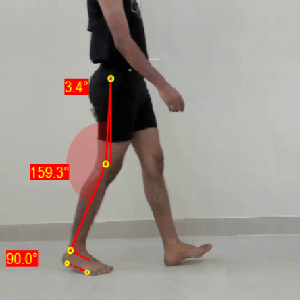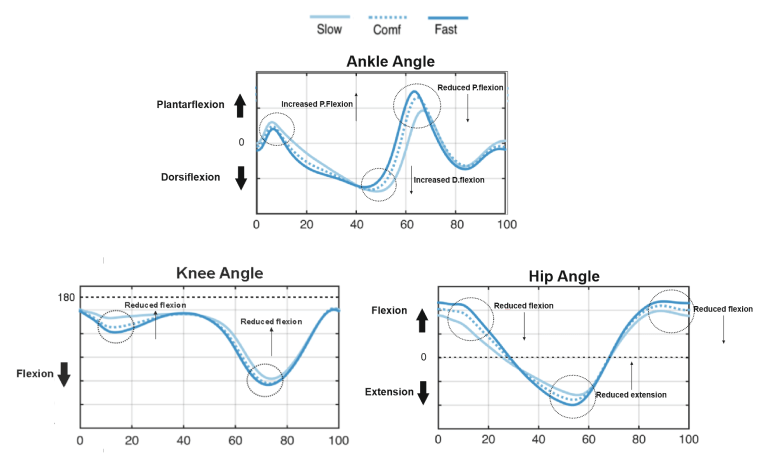Their gait parameters look off. Oh nevermind, their gait speed is high.
Have you ever performed a gait analysis, noticed that the values were outside the reference limits, and struggled to pinpoint the cause of the deviations? This scenario is more common than we might expect and can sometimes result in unnecessary conclusions about pathological gait.
While reference (normative) values provide a solid foundation for gait analysis, various physiological factors can naturally influence gait patterns, causing them to differ from the norm without indicating an underlying condition.
Parameters of Gait Analysis
A comprehensive gait analysis typically includes spatial, temporal, kinematic, kinetic, and electromyography (EMG)

Spatio-Temporal parameters
Measurement of gait in space and time. These include step length, stride length, the distance between the feet (base of support), cadence (steps/minute), step duration, gait speed, etc.

Kinematic parameters
Measurement of movement of gait.These describe the movement of body parts, such as joint angles and segmental velocities.

Kinetic parameters
Measurement of forces acting during gait. These assess the forces generated during gait, including ground reaction forces (GRFs) and joint moments.

EMG
Measurement of muscle activity during gait. Measures the electrical activity of muscles during walking, providing insight into muscle activation patterns.
Ideal vs. Pathological Gait
Based on the above parameter’s normative reference values, gait can be deemed as normal or pathological
| S.No | Parameter | Ideal | Pathological |
| 1 | Spatial |
|
|
| 2 | Temporal |
|
|
| 3 | Kinematic |
|
|
| 4 | Kinetic |
|
|
| 5 | EMG |
|
|
Influence of Non-Pathological Factors on Gait
The influence of non-pathological factors on gait parameters can be significant and varies among individuals. Here are some key non-pathological factors and their effects on gait:
- Age: Gait speed tends to decrease with age, affecting stride length and cadence.
- Gender Differences in gait patterns, including variations in stride length, cadence, and hip motion are present between males and females
- Footwear: The type of footwear can significantly impact gait parameters such as stride length, gait speed, and joint kinematics and kinetics. Footwear with cushioning can enhance comfort and stability.
- Terrain: Walking on different surfaces (e.g., grass, sand, pavement) alters gait parameters, including step frequency and gait speed, due to changes in stability and balance requirements.
- Cognitive Load: Increased cognitive demands can affect gait parameters by reducing gait speed and altering stride patterns, often leading to a shuffling gait in dual-task scenarios.
- Voluntary gait speed: It is one of the primary non-pathological factors that influences gait.
Faster walking speeds require higher muscle activation and can shift the centre of mass more dynamically, affecting balance and stability. Conversely, slow walking speeds can lead to inefficiencies and an increase in double-support time.
Effect of voluntary gait speed on gait parameters
Sr. No. | Parameter | Sub- parameters | Slower Speed* | Faster Speed* | ||||
1 | Spatial Variables | Stride Length | Reduced | Increased | ||||
Step Length | Reduced | Increased | ||||||
2 | Temporal Variables | Stance duration | Increased | Reduced | ||||
Cadence | Reduced | Increased | ||||||
3 | Joint Angles | Ankle Plantarflexion | Reduced | Increased | ||||
Ankle Dorsiflexion | Increased | Reduced | ||||||
Knee flexion | Reduced | Increased | ||||||
Hip flexion | Reduced | Increased | ||||||
Hip extension | Reduced | -DATA NOT AVAILABLE- | ||||||
4 | Joint Kinetics | Ankle Plantarflexion Moment | Reduced | Increased | ||||
Knee extension moment | Reduced | Increased | ||||||
Knee Abduction Moment | -DATA NOT AVAILABLE- | Increased | ||||||
Hip flexion moment | Reduced | Increased | ||||||
Ground Reaction Forces | Peak Vertical | Reduced | Increased | |||||
Propulsion | Reduced | Increased | ||||||
Braking | Reduced | Increased | ||||||
*Speeds are compared to comfortable walking speed
Gait Speed: Interpretation and Clinical Application
1. Spatial Variables: Stride Length and Step Length
- Slower Speeds: Both stride and step length tend to be reduced across all age groups. Shorter strides help maintain balance and stability, allowing for more control during movement. This is particularly beneficial for older adults who may prioritise stability over speed.
- Faster Speeds: Stride and step length naturally increase. Longer strides means more ground covered with each step, which enhances overall efficiency when walking faster. This adjustment is common in children and young adults, who often aim for more dynamic, quicker movement.
2. Temporal Variables: Stance Duration and Cadence
- Stance Duration:
Slower Speeds: Stance duration increases. This extended stance phase provides a more stable base of support, which can be reassuring for balance and control.
Faster Speeds: Stance duration decreases, as there’s a quick transition from one step to the next to maintain momentum. - Cadence:
Slower Speeds: Cadence, or steps per minute, decreases as there’s less urgency to move quickly. All age groups typically exhibit this pattern.
Faster Speeds: Cadence increases to keep up with the need for faster transitions between steps. This allows for smoother, more continuous movement, especially useful for children and young adults who are more likely to embrace faster paces.
3. Joint Angles: Ankle, Knee, and Hip Movements
- Ankle Plantarflexion and Dorsiflexion:
Slower Speeds: Reduced ankle plantarflexion indicates that the push-off phase is less forceful, conserving energy and favouring stability.
Faster Speeds: Both ankle plantarflexion and dorsiflexion increase to accommodate a stronger push-off and quicker foot repositioning, which facilitates speed and momentum. - Knee and Hip Joint Angles:
Slower Speeds: Knee and hip flexion tend to decrease, resulting in less knee lift and less hip forward movement. This helps conserve energy and maintains a stable gait.
Faster Speeds: Increased flexion at these joints, increasing the range of motion to enable more powerful leg movements. This adaptation helps in covering more ground quickly, with increased hip flexion being particularly crucial for driving the leg forward efficiently.

Figure 5: Effect of gait speed on joint range of motions
4. Joint Kinetics: Internal Moments at the Ankle, Knee, and Hip
- Ankle, Knee, and Hip Moments:
Slower Speeds: Lower internal moments at the ankle and knee reduce the force requirements on these joints. This allows for a more relaxed and stable gait, with less demand on muscles.
Faster Speeds: Higher internal moments are observed, especially at the knee and hip joints. These greater forces help propel the body forward, making faster movement more achievable by engaging more muscle power.
5. Ground Reaction Forces (GRFs)
- Peak Vertical GRF:
Slower Speeds: Peak vertical GRF is lower, indicating less impact with the ground. This typically reduces joints and muscle load promoting a smoother, more controlled walking pattern.
Faster Speeds: GRF increases as the feet strike the ground with greater force. While this facilitates quicker movement, it also requires the body to absorb more impact, which is generally managed well by younger adults who have more resilient musculoskeletal systems. - Propulsion and Braking Forces:
Propulsion forces, which help push the body forward, are lower at slower speeds but increase as speed rises. Higher propulsion forces allow for quicker acceleration and smoother transitions.
Braking forces are also reduced at slower speeds but increase with speed, helping to decelerate the body between steps. This balance of propulsion and braking supports control, even at faster speeds, by managing momentum efficiently.
The variations in these gait parameters with different walking speeds reflect how human bodies adapt to maintain stability, control, and efficiency. Understanding these non-pathological adaptations in gait can help appreciate the nuances of gait movements, how different speeds cater to varying physical demands and its impact on a clinician’s assessment.
GaitON offers a comprehensive 2-D Gait analysis to assess normal and pathological gait! For a demo session or to get your gait assessment done, contact us today!
ABOUT THE AUTHOR

GAYATRI SURESH (PT)
Gayatri Suresh (PT) is a Biomechanist who has completed her B.P.Th from DES College of Physiotherapy and M.P.T (Biomechanics) from SRM College of Physiotherapy, SRMIST. Her field of clinical expertise is in movement assessments through video analysis. Apart from her work at Auptimo, she works as a Clinical Specialist at Rehabilitation Research and Device Development, IIT Madras. She has been conferred with gold medals for her Research presentations and for securing First rank with distinction in her MPT degree respectively
Since you’re here…
…we have a small favor to ask. More people are reading our blogs everyday, and each week we bring you compelling content to help you treat your patients better. Please take a moment to share the articles on social media, engage the authors with questions and comments below, and link to articles when appropriate if you have a blog or participate on forums of related topics. — Team Auptimo
REFERENCES: Influence of gait speed on walking pattern
- Fukuchi, C.A., Fukuchi, R.K. & Duarte, M. Effects of walking speed on gait biomechanics in healthy participants: a systematic review and meta-analysis. Syst Rev 8, 153 (2019).
- Jakob Ziegler, Hubert Gattringer, Andreas Müller, On the relation between gait speed and gait cycle duration for walking on even ground, Journal of Biomechanics, Volume 164, 2024
- Oberg T, Karsznia A, Oberg K. Basic gait parameters: reference data for normal subjects, 10-79 years of age. J Rehabil Res Dev. 1993;30(2):210-23. PMID: 8035350.
- Oberg T, Karsznia A, Oberg K. Joint angle parameters in gait: reference data for normal subjects, 10-79 years of age. J Rehabil Res Dev. 1994 Aug;31(3):199-213. PMID: 7965878.
- Suner-Keklik, Sinem & Cobanoglu, Gamze & Ecemiş, Zeynep & Atalay Guzel, Nevin. (2023). Gender Differences in Gait Parameters of Healthy Adult Individuals. Journal of Basic and Clinical Health Sciences.
- Zhang X, Paquette MR, Zhang S. A comparison of gait biomechanics of flip-flops, sandals, barefoot and shoes. J Foot Ankle Res. 2013 Nov 6;6(1):45. doi: 10.1186/1757-1146-6-45. PMID: 24196492; PMCID: PMC3907140.